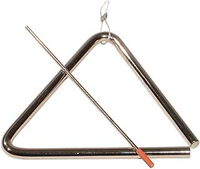Looking Backward Into the Present
Using the Popular Culture of the Past to Help Answer Perplexing Questions in the PresentArchive for beethoven
A Brief History of the Triangle as Solo Musical Instrument
I was chatting with my musician friend in a great café called Le Petite Triangle (said with a haughty French accent) when the subject turned to the triangle as a musical instrument. Since retiring from the saxophone in twelfth grade, I had been trying to find that secret shortcut to musical stardom. Could I be a solo trianglist?
My friend, who is a classically trained violinist, quickly dismissed the validity of the triangle exclaiming, “It’s part of the percussion section.” Of course, he meant that if I ever wanted to classically master the triangle as an instrument, I would have to become a percussionist. However, almost in the same breath he suggested that the triangle did have a type of tonal complexity that should not be taken lightly and could be quite demanding to master.
All jokes aside, that did get me thinking about the viability of the triangle as a solo instrument. Could it be more than a novelty? More than an Ed Grimley punchline? Were there musicians out there who took on the musical discipline of the triangle as seriously as Yo Yo Ma with the cello? If so, were the parts even available for them to play in an orchestral setting?
According to James Blades, author of Percussion Instruments and their History, the triangle in its ancient form had rings strung to the lower bar.
Yet the first mention we find of a triangle in tenth-century manuscript, is of an instrument without rings. A triangle without rings is depicted in the King Wenceslaus IV Bible (late fourteenth century) and again on a mid-fifteenth-century window in the Beauchamp Chapel, St Mary’s, Warwick. This latter triangle with its open corner has a curiously modern appearance, except that at the top angle the steel bar is twisted into a loop through which the thumb of the performer (an angel) passes.
Blades continued:
Like its ancestor the sistrum, the triangle was clearly used for religious ceremonies, quite widely in mediaeval churches judging from the frequency and virulence of the denunciations launched against them, and the necessity every few years to issue another edict prohibiting them. The triangle occurs more often than any other instrument except the cymbals in paintings of Bacchic processions and similar occasions, and angels will often be seen singing and playing a triangle at the same time.
So the triangle has a long and prestigious musical history. However, what of the triangle in its modern form, consisting of a rod of steel, open and slightly curved at one corner and meant to be struck with a steel stick or wooden handle? This was the instrument associated with the masters such as Mozart or Beethoven
According to the book, Modern Music and Musicians, “Beethoven, Mozart and many of classical as well as modern composers, have made use of this little instrument in some of their works. [The composer] Weber has used it prominently Gypsy music, as, for example, in his ‘Preciosa.’”
But in most classical musical pieces, the triangle was relegated to the background. I wanted to know if there was a composer that might utilize the triangle as a solo instrument. Could it be possible?
In my research, I discovered that Franz Lizt composed a piece, Piano Concerto No. 1, which featured the triangle as a solo instrument in the third movement. At last, I had found it, proof that the triangle should be taken seriously. It’s nickname, in fact, is called “the triangle concerto.”
So, armed with this information, I took my discovery to my musician friend. I exclaimed, “Liszt! Liszt’s Piano Concerto No. 1 features the triangle on solo!” He looked at me unimpressed and replied, “Oh yeah, I’ve played that.”
Still no respect, the journey continues.
